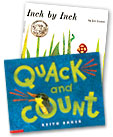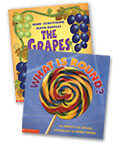|
|
 |
|
Title Selection Criteria
|
The Marilyn
Burns Classroom Math Libraries “Before you use books for a math connection, it’s important for children to first enjoy the stories and the illustrations.” – Marilyn Burns
The primary criteria used for selecting books were: the quality of their content and illustrations, and the appropriateness of the math content to address important grade-level topics. Books were chosen, not because of their reading level, but because of the grade-level math content presented.
Drawing from classic and current fiction and nonfiction children’s books, Marilyn Burns has now put together these five libraries (Kindergarten, Grade 1, Grade 2, Grade 3, and Grades 4–6) —all appropriate for reading aloud. Each of the libraries addresses the math standards as described by the National Council of Teachers of Mathematics (NCTM) in Principles and Standards for School Mathematics (NCTM, 2000), and reflected in most state and district mathematics frameworks: • Standard 1 Number and Operations
• Standard 2 Algebra
• Standard 3 Geometry
• Standard 4 Measurement
• Standard 5 Data Analysis and Probability
Because Standard 1, Number and Operations, is the cornerstone of K–6 mathematics and receives the most attention nationwide, it receives the most attention in each of the libraries. Therefore you'll find more titles that focus on the time-honored third “R” of education. From counting to place value to addition, subtraction, multiplication, division, and fractions, lessons address the three essential aspects of arithmetic instruction—computation, number sense, and problem solving. |
||||||||||||
 All the books in these libraries are meant to be read aloud as a springboard for math lessons. Because some books presented opportunities for math lessons appropriate in more than one grade, it was a challenge to make choices about which books belonged in each library without repeating titles among grades. The result is five distinct libraries with a total of 125 different books and 125 lessons.
All the books in these libraries are meant to be read aloud as a springboard for math lessons. Because some books presented opportunities for math lessons appropriate in more than one grade, it was a challenge to make choices about which books belonged in each library without repeating titles among grades. The result is five distinct libraries with a total of 125 different books and 125 lessons. Over the past decade, Marilyn Burns has assembled a substantial collection of favorite children’s books that are well suited for classroom math lessons, along with lesson ideas for using the books to teach math concepts and skills. She has taught these lessons in classrooms, revised them as a result of students’ responses, and presented them in workshops, at conferences, and in articles and professional books. The goal has been to help teachers see that by beginning math lessons with children’s books they can spark students’ excitement about learning mathematics.
Over the past decade, Marilyn Burns has assembled a substantial collection of favorite children’s books that are well suited for classroom math lessons, along with lesson ideas for using the books to teach math concepts and skills. She has taught these lessons in classrooms, revised them as a result of students’ responses, and presented them in workshops, at conferences, and in articles and professional books. The goal has been to help teachers see that by beginning math lessons with children’s books they can spark students’ excitement about learning mathematics.